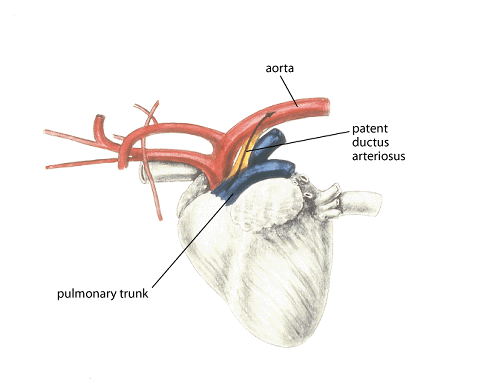Canine Patent Ductus Arteriosus
& Breeds at Risk
Research, Resources & Education
This website is based on research and is NOT created to diagnose your pet.
Each animal is an individual and may exhibit symptoms in a different way.
It is advised that you ALWAYS CHECK WITH YOUR VETERINARIAN for a proper diagnosis and treatment plan.
Table of Contents
Patent ductus arteriosus (PDA)
Persistent flow through the ductus leads to excess blood flow (volume overload) to the pulmonary circulation and left heart chambers, most commonly leading to left CHF within the first 1–2 years of life.
Symptoms: As the disease process progresses heart failure can ensue which include signs of shortness of breath, coughing, weakness, and exercise intolerance.
Treatment: The goal of treatment for a forward flowing PDA is to stop the blood flowing through the shunt. There is no surgical treatment for a reverse PDA.
What Dogs are at Risk?
Some Dogs that are at Risk due to Genetic Predisposition


















What is Patent Ductus Arteriosus
What is PDA? (Merck Manual)
What is PDA? Merck Manual
Patent ductus arteriosus (PDA) is a common congenital defect of dogs, and it occurs less commonly in cats.
- Persistent flow through the ductus leads to excess blood flow (volume overload) to the pulmonary circulation and left heart chambers, most commonly leading to left CHF within the first 1–2 years of life.
- PDA occurs most commonly in small-breed dogs and causes a continuous murmur loudest over the left base and bounding pulses.
- Prompt diagnosis and treatment (either by interventional device occlusion or surgical ligation) before the development of clinical signs is associated with an excellent outcome.
- A loud, continuous, left basilar heart murmur and bounding femoral pulses are classically found on physical examination.
- Left heart failure (pulmonary edema) is the most common sequelae of PDA, commonly occurring within the first year of life.
- Treatment (interventional device occlusion or surgical ligation) before the onset of clinical signs is associated with an excellent prognosis.
Patent Ductus Arteriosus Videos
YouTube Videos that help explain Patent Ductus Arteriosus in Dogs
Disclaimer:
This is for research only and Lost Temple Pets does not endorse any video presented on this website.
It is advised that you ALWAYS CHECK WITH YOUR VETERINARIAN for a proper diagnosis and treatment plan.
Causes / Risks
Risks (VCA Animal Hospital)
Risks VCA Animal Hospital
- Patent ductus arteriosus is more common in female dogs.
- Although any breed of dog can be affected by this heart defect, PDA does appear to have a heritable component in smaller dog breeds.
- This defect appears to run in families (genetic).
- Affected dogs should not be bred, even if the condition is successfully treated.
Symptoms / Diagnosis
Left to Right & Reverse (Merck Manual)
Left to Right & Reverse Merck Manual
Left to Right
In animals with a left-to-right patent ductus arteriosus, a prominent, continuous, machinery-like murmur is present.
- The murmur is usually loudest at the left base of the heart and is often associated with a precordial thrill.
- In some cases, the ductus remains open for several days after birth, so a continuous murmur may be detected during examination of the neonate.
- Femoral pulses are typically bounding.
- Most young animals do not demonstrate clinical signs. Those with a large shunt and older animals often have signs of left-side CHF.
Reverse
In animals with a reverse PDA, there is usually a history of lethargy, exercise intolerance, and collapse that relates to severe pulmonary hypertension and venous admixture.
- Careful examination may reveal differential cyanosis.
- Cardiac auscultation may reveal a right-side systolic murmur (tricuspid regurgitation), split S2, and a soft diastolic murmur (pulmonic insufficiency).
- A continuous murmur is not present, and femoral pulses are not bounding.
Symptoms / Diagnosis (Merck Manual – Patient Version)
Symptoms / Diagnosis – Merck Manual – (Patient Version)
In animals with a patent ductus arteriosus with right-to-left shunting, there is usually a history of fatigue, exercise intolerance, and collapse.
- Careful examination may reveal a slight bluish tinge to skin and membranes in the back half of the dog (that is, the limbs and trunk rather than the head and neck).
- Your veterinarian may note other abnormalities such as a split heart sound, a soft murmur, or an abnormal increase in red blood cells.
- Electrocardiography, x-rays, and echocardiography may be useful in diagnosis.
Clinical Signs (Cornell College of Veterinary Medicine)
Clinical Signs – Cornell College of Veterinary Medicine
As the disease process progresses heart failure can ensue which include signs of:
- Shortness of breath
- Coughing
- Weakness
- Exercise intolerance.
Diagnosis and Testing
Diagnosis and Testing (Cornell College of Veterinary Medicine)
Diagnosis and Testing Cornell College of Veterinary Medicine
Diagnosis
Most cases of patent ductus arteriosus are found when a perfectly healthy-looking puppy or kitten is brought to the veterinarian for a routine examination, and a heart murmur is detected.
- A heart murmur is the sound produced by blood moving through the heart in a turbulent fashion and can be heard by the veterinarian by using a stethoscope.
- If there is a concern that the murmur may indicate a patent ductus arteriosus (these PDA murmurs produce a very distinctive sound), then tests are warranted to evaluate the possibility of patent ductus arteriosus.
Tests
- Usually, x-rays are taken of the chest to evaluate the size and shape of the heart and to evaluate the lungs.
- An electrocardiogram (ECG) depicts the pattern of electrical activity in the heart and any irregularities in the heart’s rhythm (arrhythmias). The ECG may show changes that support a diagnosis of a PDA.
- An echocardiogram, (cardiac ultrasound), is the test of choice for a PDA. An image of the inside of the heart is displayed on a monitor in real time and allows the cardiologist to observe the abnormal communication between the aorta and pulmonary artery
Treatment
What is the treatment for a PDA? (VCA Animal Hospital)
What is the treatment for a PDA? VCA Animal Hospital
- The goal of treatment for a forward flowing PDA is to stop the blood flowing through the shunt. Your veterinarian will refer you to a veterinary cardiovascular surgeon, who will determine the optimal treatment for your dog.
- In some cases, the ductus will be tied off during heart surgery.
- In other cases, a less invasive surgical treatment may be an option.
- The less invasive procedure involves occlusion (blocking) of the ductus arteriosus with either a transarterial coil or a ductal occluder device, which is placed by means of cardiac catheterization.
- Surgical repair should be performed as soon as possible. The longer the surgery is delayed, the more likely it is that irreversible heart damage will occur.
- If the dog shows signs of heart failure, pre-surgical stabilization will be necessary.
- There is no surgical treatment for a reverse PDA.
- Medical treatment will help manage the symptoms, but a cure is not possible for dogs with a reverse PDA, and it will inevitably be fatal.
References
References
Cornell College of Veterinary Medicine – Patent Ductus Arteriosus
https://www.vet.cornell.edu/hospitals/services/cardiology/patent-ductus-arteriosus
Merck Manual – Patent Ductus Arteriosus in Animals
By Sandra P. Tou, DVM, DACVIM-Cardiology, DACVIM-SAIM
Reviewed/Revised Jan 2020
Merck Manual – Patient Version – Congenital and Inherited Disorders of the Cardiovascular System in Dogs
By Sandra P. Tou, DVM, DACVIM-Cardiology, DACVIM-SAIM, Department of Clinical Sciences, College of Veterinary Medicine, North Carolina State University
Reviewed/Revised Jun 2018
VCA Animal Hospital – Patent Ductus Arteriosus in Dogs
By Courtney Barnes, BSc, DVM; Malcolm Weir, DVM, MSc, MPH; Cheryl Yuill, DVM, MSc, CVH
https://vcahospitals.com/know-your-pet/patent-ductus-arteriosus-in-dogs
VIDEOS
iHeartChange – PDA
https://www.youtube.com/watch?v=7DKaCqubuSg
AuburnVetMed – Symptoms of Patent Ductus Arteriosus (PDA)
https://www.youtube.com/watch?v=HAt1oTwtWWA
Stonnie Dennis – Canine Patent Ductus Arteriosus (PDA) | Post Heart Surgery Results
https://www.youtube.com/watch?v=sltKLYbJPPk
Stonnie Dennis – Jack Russell Terrier Heart Condition Update | Patent Ductus Arteriosus (PDA)
Cardiac/Breed Chart
| BREED | Atrial septal defect (ASD) | Chronic mitral valvular disease (CMVDz) | Dilated cardiomyopathy (DCM) | Mitral valvular dysplasia (MVD) | Patent ductus arteriosus (PDA) | Pulmonic stenosis (PS) | Subaortic stenosis (SAS) | Tricuspid valvular dysplasia (TVD) | |
|---|---|---|---|---|---|---|---|---|---|
| Affenpinscher | Patent ductus arteriosus (PDA) | ||||||||
| Afghan Hound | Dilated cardiomyopathy (DCM) | Mitral valvular dysplasia (MVD) | |||||||
| Airedale Terrier | |||||||||
| Akita (American) | |||||||||
| Alaskan Malamute | |||||||||
| American Eskimo, Toy and Standard | |||||||||
| American Foxhound | |||||||||
| American Pitt Bull Terrier | |||||||||
| American Staffordshire Terrier | |||||||||
| American Water Spaniel | |||||||||
| Anatolian Shepherd Dog | |||||||||
| Australian Cattle Dog | |||||||||
| Australian Shepherd | |||||||||
| Australian Terrier | |||||||||
| Basenji | |||||||||
| Basset Hound | Pulmonic stenosis (PS) | ||||||||
| Beagle | Pulmonic stenosis (PS) | ||||||||
| Bearded Collie | |||||||||
| Beauceron | |||||||||
| Bedlington Terrier | |||||||||
| Belgian Groenendael | |||||||||
| Belgian Malinois | |||||||||
| Belgian Tervuren | |||||||||
| Bernese Mountain Dog | |||||||||
| Bichon Frise’ | Patent ductus arteriosus (PDA) | ||||||||
| Black and Tan Coonhound | |||||||||
| Black Russian Terrier | |||||||||
| Bloodhound | |||||||||
| Boerboel | |||||||||
| Border Collie | |||||||||
| Border Terrier | |||||||||
| Borzoi | |||||||||
| Boston Terrier | Pulmonic stenosis (PS) | ||||||||
| Bouvier des Flandres | Subaortic stenosis (SAS) | ||||||||
| Boxer | Atrial septal defect (ASD) | Dilated cardiomyopathy (DCM) | Pulmonic stenosis (PS) | Subaortic stenosis (SAS) | |||||
| Briard | |||||||||
| Brittany | |||||||||
| Brussels Griffon | |||||||||
| Bull Terrier | Mitral valvular dysplasia (MVD) | ||||||||
| Bull Terrier, Miniature | |||||||||
| Bulldog, English | Pulmonic stenosis (PS) | Subaortic stenosis (SAS) | |||||||
| Bullmastiff | |||||||||
| Cairn Terrier | |||||||||
| Canaan Dog | |||||||||
| Cane Corso (Italian Mastiff) | |||||||||
| Caucasian Shepherd | |||||||||
| Cavalier King Charles Spaniel | Chronic mitral valvular disease (CMVDz) | Patent ductus arteriosus (PDA) | |||||||
| Chesapeake Bay Retriever | |||||||||
| Chihuahua | Chronic mitral valvular disease (CMVDz) | Patent ductus arteriosus (PDA) | Pulmonic stenosis (PS) | ||||||
| Chinese Crested | |||||||||
| Chinese Shar-Pei | |||||||||
| Chow Chow | Pulmonic stenosis (PS) | ||||||||
| Clumber Spaniel | |||||||||
| Cocker Spaniel (American) | Chronic mitral valvular disease (CMVDz) | Dilated cardiomyopathy (DCM) | Patent ductus arteriosus (PDA) | Pulmonic stenosis (PS) | |||||
| Collie, Rough / Smooth Coat | Patent ductus arteriosus (PDA) | ||||||||
| Curly Coated Retriever | |||||||||
| Dachshund | Chronic mitral valvular disease (CMVDz) | ||||||||
| Dalmation | |||||||||
| Dandie Dinmont Terrier | |||||||||
| Doberman Pinscher | Atrial septal defect (ASD) | Dilated cardiomyopathy (DCM) | |||||||
| Dogo Argentino | |||||||||
| Dogue de Bordeaux (Mastiff) | |||||||||
| English Cocker Spaniel | Dilated cardiomyopathy (DCM) | Pulmonic stenosis (PS) | |||||||
| English Foxhound | |||||||||
| English Setter | |||||||||
| English Springer Spaniel | Dilated cardiomyopathy (DCM) | Patent ductus arteriosus (PDA) | |||||||
| English Toy Spaniel AKA King Charles Spaniel | |||||||||
| Field Spaniel | |||||||||
| Finnish Spitz | |||||||||
| Flat-Coated Retriever | |||||||||
| Fox Terrier, Smooth | |||||||||
| Fox Terrier, Toy | |||||||||
| Fox Terrier, Wire | Pulmonic stenosis (PS) | ||||||||
| French Bulldog | |||||||||
| German Pinscher | |||||||||
| German Shepherd | Dilated cardiomyopathy (DCM) | Mitral valvular dysplasia (MVD) | Patent ductus arteriosus (PDA) | Subaortic stenosis (SAS) | Tricuspid valvular dysplasia (TVD) | ||||
| German Shorthaired Pointer | Subaortic stenosis (SAS) | ||||||||
| German Wirehaired Pointer | |||||||||
| Glen of Imaal Terrier | |||||||||
| Golden Retriever | Dilated cardiomyopathy (DCM) | Subaortic stenosis (SAS) | |||||||
| Gordon Setter | |||||||||
| Great Dane | Dilated cardiomyopathy (DCM) | Mitral valvular dysplasia (MVD) | Subaortic stenosis (SAS) | Tricuspid valvular dysplasia (TVD) | |||||
| Great Pyrenees | |||||||||
| Greater Swiss Mountain Dog | |||||||||
| Greyhound | |||||||||
| Harrier | |||||||||
| Havanese | |||||||||
| Ibizan Hound | |||||||||
| Irish Setter | Tricuspid valvular dysplasia (TVD) | ||||||||
| Irish Terrier | Patent ductus arteriosus (PDA) | ||||||||
| Irish Water Spaniel | |||||||||
| Irish Wolfhound | Dilated cardiomyopathy (DCM) | ||||||||
| Italian Greyhound | |||||||||
| Japanese Chin | |||||||||
| Keeshond | Patent ductus arteriosus (PDA) | Pulmonic stenosis (PS) | |||||||
| Kerry Blue Terrier | Patent ductus arteriosus (PDA) | ||||||||
| Komondor | |||||||||
| Kuvasz | |||||||||
| Labrador Retriever | Dilated cardiomyopathy (DCM) | Patent ductus arteriosus (PDA) | Pulmonic stenosis (PS) | Tricuspid valvular dysplasia (TVD) | |||||
| Lakeland Terrier | |||||||||
| Lhasa Apso | Chronic mitral valvular disease (CMVDz) | ||||||||
| Lowchen | |||||||||
| Maltese | Chronic mitral valvular disease (CMVDz) | Patent ductus arteriosus (PDA) | |||||||
| Manchester Terrier Toy | |||||||||
| Manchester Terrier, Standard | |||||||||
| Mastiff, English | Dilated cardiomyopathy (DCM) | Pulmonic stenosis (PS) | |||||||
| Miniature Pincher | |||||||||
| Neapolitan Mastiff | |||||||||
| Newfoundland | Dilated cardiomyopathy (DCM) | Patent ductus arteriosus (PDA) | Pulmonic stenosis (PS) | Subaortic stenosis (SAS) | |||||
| Norfolk Terrier | |||||||||
| Norwegian Buhund | |||||||||
| Norwegian Elkhound | |||||||||
| Norwich Terrier | |||||||||
| Nova Scotia Duck Tolling Retriever | |||||||||
| Old English Sheepdog | Atrial septal defect (ASD) | Dilated cardiomyopathy (DCM) | Tricuspid valvular dysplasia (TVD) | ||||||
| Otterhound | |||||||||
| Papillon | Chronic mitral valvular disease (CMVDz) | ||||||||
| Parsons Russell Terrier | |||||||||
| Pekingese | Chronic mitral valvular disease (CMVDz) | ||||||||
| Petit Basset Griffon Vendeen (PBGV) | |||||||||
| Pharaoh Hound | |||||||||
| Plott Hound | |||||||||
| Pointer | Subaortic stenosis (SAS) | ||||||||
| Polish Lowland Sheepdog | |||||||||
| Pomeranian | Chronic mitral valvular disease (CMVDz) | Patent ductus arteriosus (PDA) | |||||||
| Poodle, Miniature | Chronic mitral valvular disease (CMVDz) | Patent ductus arteriosus (PDA) | |||||||
| Poodle, Standard | Atrial septal defect (ASD) | Patent ductus arteriosus (PDA) | |||||||
| Poodle, Toy | Chronic mitral valvular disease (CMVDz) | Patent ductus arteriosus (PDA) | |||||||
| Portuguese Water Dog | Dilated cardiomyopathy (DCM) | ||||||||
| Presa Canario | |||||||||
| Pug | |||||||||
| Puli | |||||||||
| Pyrenean Shepherd | |||||||||
| Rhodesian Ridgeback | |||||||||
| Rottweiler | Subaortic stenosis (SAS) | ||||||||
| Saluki | |||||||||
| Samoyed | Atrial septal defect (ASD) | Pulmonic stenosis (PS) | Subaortic stenosis (SAS) | ||||||
| Schipperke | |||||||||
| Schnauzer, Miniature | Chronic mitral valvular disease (CMVDz) | Pulmonic stenosis (PS) | |||||||
| Schnauzer, Giant | Pulmonic stenosis (PS) | ||||||||
| Schnauzer, Standard | |||||||||
| Scottish Deerhound | Dilated cardiomyopathy (DCM) | ||||||||
| Scottish Terrier | |||||||||
| Sealyham Terrier | |||||||||
| Shetland Sheepdog | Patent ductus arteriosus (PDA) | ||||||||
| Shiba Inu | |||||||||
| Shih Tzu | Chronic mitral valvular disease (CMVDz) | ||||||||
| Siberian Husky | |||||||||
| Silky Terrier | |||||||||
| Skye Terrier | |||||||||
| Soft-Coated Wheaten Terrier | |||||||||
| Spinone Italiano | |||||||||
| St. Bernard | Dilated cardiomyopathy (DCM) | ||||||||
| Staffordshire Bull Terrier | |||||||||
| Sussex Spaniel | |||||||||
| Swedish Vallhund | |||||||||
| Tibetan Mastiff | |||||||||
| Tibetan Spaniel | |||||||||
| Tibetan Terrier | |||||||||
| Tosa | |||||||||
| Vizsla | |||||||||
| Weimaraner | |||||||||
| Welsh Corgi, Cardigan | Patent ductus arteriosus (PDA) | ||||||||
| Welsh Corgi, Pembroke | Patent ductus arteriosus (PDA) | ||||||||
| Welsh Springer Spaniel | |||||||||
| Welsh Terrier | |||||||||
| West Highland White Terrier | Chronic mitral valvular disease (CMVDz) | Pulmonic stenosis (PS) | |||||||
| Whippet | |||||||||
| Wirehaired Pointing Griffon | |||||||||
| Yorkshire Terrier | Chronic mitral valvular disease (CMVDz) | Patent ductus arteriosus (PDA) | |||||||
| Spanish Mastiff | |||||||||
| Treeing Walker Coonhound | |||||||||
| Barbet | |||||||||
| Cirneco dell'Etna | |||||||||
| Broholmer | |||||||||
| Leonberger | |||||||||
| Rat Terrier | |||||||||
| Xoloitzcuintli | |||||||||
| Dutch Shepherd |
